“Discussions about a specific tea should be left until during and after the sipping and too many words simply lead one to question the speaker”.
– Ms. Lu, Tea Master – Kunming
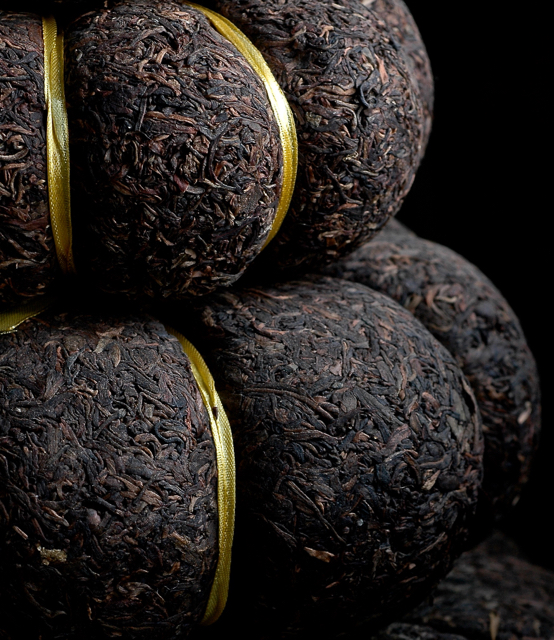
Pu erh in its ripe or ‘Shou’ version. Artificially aged with bacteria and humidity. Shaped teas were and still are common in the Pu erh world, though not all Pu erh is formed or moulded.
There is always time for a little ‘destruction’ when too much mystification takes hold. This applies to everything from education to the world – and leaves – of tea, and far beyond. Mystification can be a great enemy when it comes to trying to establish basic truths. With Pu erh’s ever-shifting place and growing popularity upon the palates of drinkers – and its rise from a simple caravan tea into something approaching a boutique commodity – it becomes necessary to add some simple thoughts to all of the rehashed, hashed, and otherwise bits of information on the big leaves of Pu erh. Mystification in Pu erh’s world comes from some of its legitimate claims, but it also comes from regurgitated misinformation, marketing, and the intensely pretentious. Mystification, though, can also serve to hide or manipulate knowledge and create hype, and it is at this, that this little bit of writing is directed. What makes deliberate or simply ignorant information so damaging is that for many who are unable (but willing) to seek out genuine knowledge the task becomes more like wandering through a haze of faintly visible shapes: close but never really there. As always too, as interest increases in any item there are those who take all information as either doctrine or suspect. Tea is a thing of the earth from where it comes, the hands that produce and nurture it, and then with a bit of added heat it waits for its first infusion. Those facts should not be muddled by words, otherworldly terminology nor flattery.
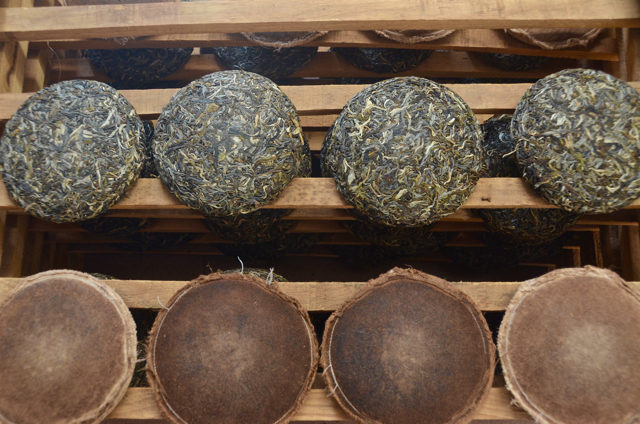
Raw or ‘Sheng’ Pu erh. Basically a green unmolested tea that will age naturally given oxygen, time and its own innate chemistry. For most locals who grow and know tea, far superior.
A Pu erh for locals in southwest Yunnan Province, who cultivate and harvest the leaves, and for some of the regulatory bodies that are trying to assign a specific set of guidelines for Pu erh, the truth is fairly simple as to what Pu erh actually is. A Pu erh must be a big leaf species, should be grown, cultivated and produced in Yunnan, and should be sun-shade dried. That is it really. Though there are big leaf trees and shrubs growing in Myanmar, Assam and Loas, the above three simple designates are vital to at least establish a context of what Pu erh is. In the myriad of words written and spoken about Puerh it is remarkable that fewer explain the vital role and history of the producers and hands behind the leaves. Even in a greater context it is often these characters behind the leaves that speak more clarity in minutes than some of the extravagance heard in the wider sphere of the tea world. It is a shame that they cannot be the tale-tellers of their leaves, rather than wordsmiths.
Aged teas have become one of the most irritating talking points and mystifications regarding Pu erh. An aged tea is simply a tea that has been around in cake/loose/brick form for years or decades. With some drinkers making sublimely ridiculous claims that they “will not drink a tea that is less than 25 years old”, or “40 years” – or more in age, it seems the lunatic and pretentious realms are close at hand. Entire forums of debate and discussion exist to rank aged teas without the contributors ever having sampled a simple raw Pu erh (a ‘green’ version that is simply picked, withered, fried, and dried) from a verified source. There is much of the world of trendiness moving into the world of Pu erh and with it some wonderfully idiotic terminology. This combined with claims such as the above threaten some fundamentals of a timelessly pungent and slightly rough bit of beauty. In many cases claims are made without even an understanding of some basic Pu erh knowledge or of the people behind the tea who’ve created it. In the words of one of my indigenous and astute tea mentors in Banzhang, southwestern Yunnan, “When someone says too much about tea, their palates are surely missing much”. The world of Pu erh is so very much more than simply ripened and aged decaying beauties (and not so beautiful beauties). For samples of exquisite Pu erhs one finds no better place than the source where Pu erhs are consumed in rampant fashion in its green ‘raw’ (Sheng) form, that will in time age itself slowly. An irony that in the very original bastions of Pu erh tea cultivation, the locals turn their noses at the notion that one would deliberately manipulate an astringent vegetal bit of brilliance. In the Pu erh tea cultivating regions, nothing is better than a bit of potently fresh Pu erh. Aged teas are viewed a something of a waste, though marketing has turned this ‘aged-tea phenomenon’ into something commercial beyond all other things. In the words of Mr. Gao, another mentor of Banzhang, “To know a tea, you need to know the land and the hands that made it”. There are no hard and fast rules regarding a tea’s age. If one knows or trusts the source, has a palate reference point, the rest is up to the mouth.
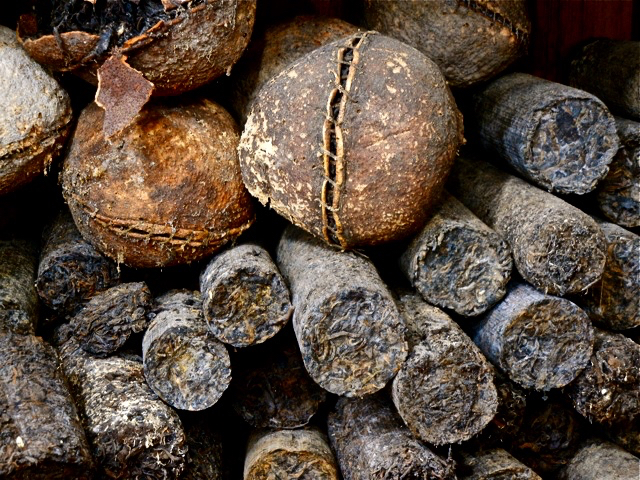
Legitimately old Pu erh teas in cylinder form lying in a disintegrating pile in a Kunming tea market. Whether they actually have more developed or ‘superior’ flavours is still up to palates rather than rankings or price.
I once joined a tea buyer of repute from Guangdong as he raided the attics of an old Hani household looking for antiquities (old tea cakes, bricks, cylinders). When I asked him why he looked in the attics, he told me that the locals would simply forget that they had the old teas, and that if they did remember they would likely not touch them. He himself was a perfect example of a mentor. Softly spoken and hailing from a farm, he had the palate of a true taster. He would often listen to people wax on about flavour ranges, and their own expertise with a half-smile upon his face. He once said “It is interesting to me that these people speak so much of what is desirable in a Pu erh, when it is clear that they don’t know the very basics of what a Pu erh is”. When asked to clarify, he said, “Everyone is interested what tea-mountain the tea comes from. The name, the age…a good tea is a good tea and sometimes that is all one need understand”.
Some little notions on aged teas (as opposed to freshly harvested teas from ancient trees) that are vital and – and often vitally missing – on the subject of Pu erh. It is increasingly difficult to understand how certain aged Pu erhs selling for hundreds and thousands of dollars, and that can easily be faked, rigged, and hyperbolized can continually occupy such a width of fascination. The age of a particular tea, its creator, its nicely desecrated wrap, and even its hints of pungent mustiness that inundate every particle can be easily manipulated with very little sign of playing. In fact the older a cake is reputed to be, the more it should arise a slight bit of suspicion. Ripe blacks, deliberately manipulated with bacteria and humidity can easily serve to function (with some added finesse) as an old tea. While the nuttiness and smooth flavours of either ripened or naturally oxidized teas are, like all things, subjective, one still needs to know from where and whom it came. I come again back to the indigenous people who grow and nurture the trees and bushes. They look at tea as something inextricably bound to the earth and to themselves and the more the manipulation and adulteration of tea, the farther from a tea it becomes. Said simply, deliberate addition of bacteria to speed up ageing isn’t something desirable. Genuinely old teas that are over 20 or 30 years old are not that common, though one wouldn’t know it looking at the multitudes selling it. A tea over 30 years old runs the risk of becoming nothing but dust. Teas rarely develop anything extra in flavor beyond that age, so what are consumers hoping to find? If one has the choice between a tea from an ancient tree or an aged 30 year old cake (with no indication of age of tree or bush), I’d take the ancient tree tea every single time (and save a lot of money).
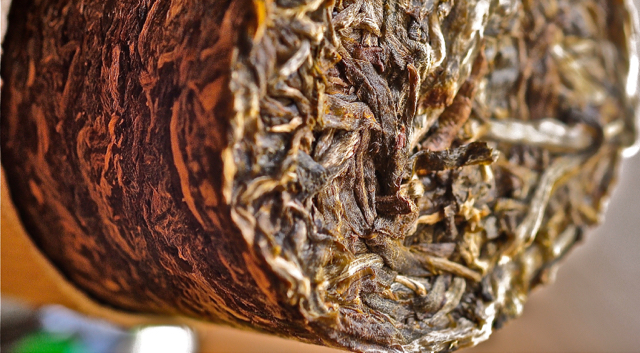
One of the most ancient of the ‘formed’ teas. This form of compressing tea in a bamboo husk goes back to ancient times and it was common for the Dai minority to store and transport leaves this way.
Pu erh tea’s brilliance comes from the fact that it is so inconsistent from season-to-season, batch-to-batch, and year-to-year. Compare it to a high-mountain Wulong where craft and timing are vital to the fermenting art; compare it to the magnificent consistency of a Japanese green Sencha, where one can be certain with the expectation that each Spring’s offering from a particular producer will feel like a well rehearsed bit of ritual. Contrast this with the world of Pu erh where consistency is prized but not assured and yet still the prices of fantastically fresh Pu erhs astound. A fresh Spring Pu erh harvest of Lao Banzhang, Bing Dao, Bang Ma, or Pa Sa, can elicit hundreds and even thousands of dollars per kilo in its fresh potently raw form. The price, though partially hype and marketeering at its most voracious, is at least a bit down to the fact that these ancient trees have never been sprayed, and that the process to produce such gems is largely unchanged. The source, the producer, and the age of the trees all adds a special bit of aura to the value. Said another way, what is unchanged and simple, contributes to the worth and desirability of the tea, rather than simply a purported ‘age’ of a tea.
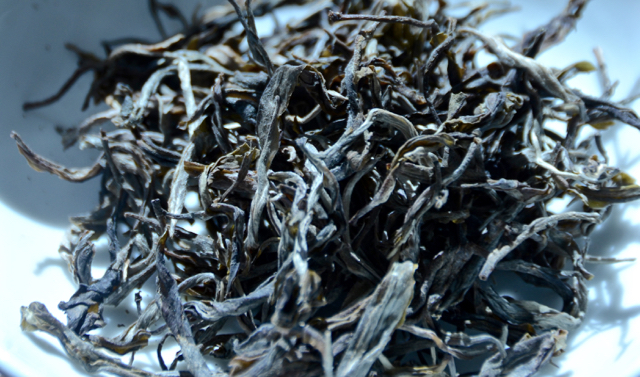
Though not as well known outside of Yunnan, Pu erh big leaves often appears as simply loose, uncompressed tea. Here, an example of ancient tree’s leaves.
Pu erh is a kind of cowboy in the tea world. An inconsistent, swarthy brute at times that can in turns be wonderfully subtle and full of grace and at others be pungent and molar grabbing. There are no rules or clever divining about which Pu erh will age well or what year will produce a stunner. In the world of tea, the plants that thrive and produce masterpieces generally have gone through stresses of drought or climactic extremes. This ‘stress-factor’ is one of the great under-stated truths of a great plant, tree, bush, or arboreal of the camellia family and particularly for the big-leaf Pu erhs. Tea bushes that undergo stress generally pass one of Mother Nature’s great informal exams and end up producing something exquisite. There should be stimulant compounds within, and it should have a slight astringency. Bitterness is not an enemy but rather simply to gradually understand in the mouth.
What creates a classic in the tea world is as varied as there are teas. The market – as it does with so much – decides a tea’s value, but so too does some of the absolutes of a classic Pu erh: astringent bite, vegetal strength with a sweet finish. What can be said about a Pu erh is that it is consistently the variations and vegetal power of a new harvest that are sought after by the palates of locals. A tea’s age (or purported age) in the lands that grow so many classic Pu erhs, will get scarce attention compared to a fresh Spring harvest zinger from one of the classic tea mountains: Bulang, Yiwu, Banzhang, Nannuo, Naka…
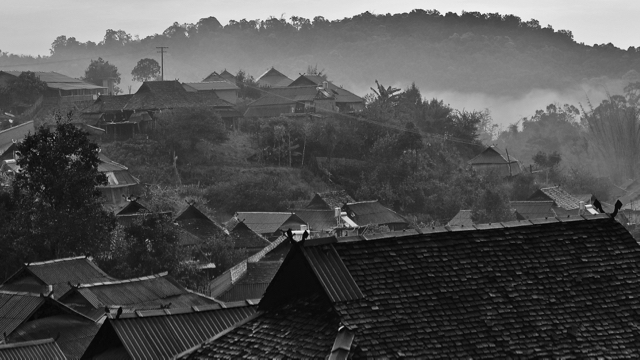
Back in 2004 when I first visited the famed Pu erh village of Lao Banzhang. Now, the thatched homes have been replaced with mansions as the growers are now rolling in the funds that their fabulous teas’ summon.
Pu erh holds the distinction of being the one tea that will age and develop over time rather than simply wither away into dust. This ageing is real and differs from the forced ‘ripening’ process brought on by additional humidity and bacteria. This kind of ageing is entirely natural, but again doesn’t necessarily mean, the tea will be any better. No re-roasting to revitalize it like some of the gorgeous Wulongs, no shading before plucking like the classic Japanese greens. An average Puerh, with a bit of alchemic vim, can become a classic ageing with only oxygen and time.
The above serves or attempts to open up the wider and more ‘real’ world of Pu erhs and was also stimulated by a deluge of very limited rehashed information on the world of Pu erh and by one particular individual’s recent (and preposterous) claim that he “wouldn’t touch a Pu erh that isn’t at least 10-years’ old”…all while never having sampled any Sheng (raw or green) Pu erh in his life. The palate, some trust in the source, and some good leaves…along with some time are the only requisites.

Here, in Jing Mai elders from the Dai minority sort stems and damaged leaves (still very drinkable) from the rest. Tea at its core in these regions is still very much something of the hands.
Random Pu erh Bits
Puerh’s have to be big-leafed camellia species
One doesn’t have to chuck the first rinse infusion. The first rinse which is often thrown away is generally used to awaken the leaves, eliminate a little of the bitterness and to simply remove errant dust and bits from the tea
Big leafed tea was used long ago in Myanmar by the royalty as a foodstuff where leaves would be stored within bamboo, which were in turn buried in the earth. After months or even years the leaves would be uncovered and eaten in this potent and pungent form at celebrations
It was the big leaf ‘Pu erh’ teas that the Mongols (once rulers of the Han empire and establishers of the Yuan Dynasty) brought back in brick and cylinder form to their distant yurts
Arguably the best Pu erhs (and certainly the oldest trees) on the globe are produced and cultivated in indigenous lands in southern Yunnan’s Xishuangbanna region, though the big leafed species can also be found in Myanmar, Assam, Laos and Thailand
Indigenous minorities including the Dai, Bulang, Wa, Hani, and Lahu all produce fabulously simple ‘Puerh’ teas
The indigenous have long used tea in concert with other plants and herbs as a medicine. Honey, orange blossom, peppercorns, chilli peppers, and even garlic have all been used
The name Pu erh is of an ancient tea market town in southern Yunnan province
Pu erhs can age naturally and develop other benefits over time, unlike other smaller leaf camellia species which simply wither and flat-line (unless re-roasted) after about 18-24 months. Pu erhs don’t really have a shelf-life as they will continue to develop
Puerhs need aeration to age. To store Pu erh cakes or loose leaves allow a space that isn’t an air tight container, and should be kept away from odors, spices, humidity
Pu erhs were called Ja Kabow (bitter tea) by the Tibetans and were known as some of the first teas to travel along the Tea Horse Road days over thirteen centuries ago
Pu erhs come in bush and arboreal form and can grown into great gargoyle-like trees that spread their bows wide
Pu erhs come in raw green form (called Sheng in Mandarin) or in ripe versions (called Shou in Mandarin). A raw Pu erh is essentially a green tea with the caveat that it will age for years altering in fragrance, flavor and appearance. A ripened version goes through an artificial speed-fermenting that attempts to mirror a naturally aged raw Pu erh
Indigenous groups of southern Yunnan have used Pu erh leaves for headaches, soothing fevers, weak circulation, pancreatic stimulation, cooling and soothing nerves and heart conditions. They have even used tea leaves as poultices on external wounds to heal scar tissue
Tea in the Chinese medicinal frame of reference is a coolant and something on the ‘bitter’ chart of flavors. Bitter foods are generally regarded as being beneficial to the heart and nervous system
Teas are in various potencies, both anti-inflammatory and anti-bacterial
Pu erhs fall into different source types: young bushes, middle-aged bushes, old trees, and ancient trees. There are also wild tea trees throughout south central and southwest Yunnan. All are big leaf varieties
Prices of Pu erh depend on (in no particular order) age of bush/tree, harvest season (Spring is most valued), producer, and region



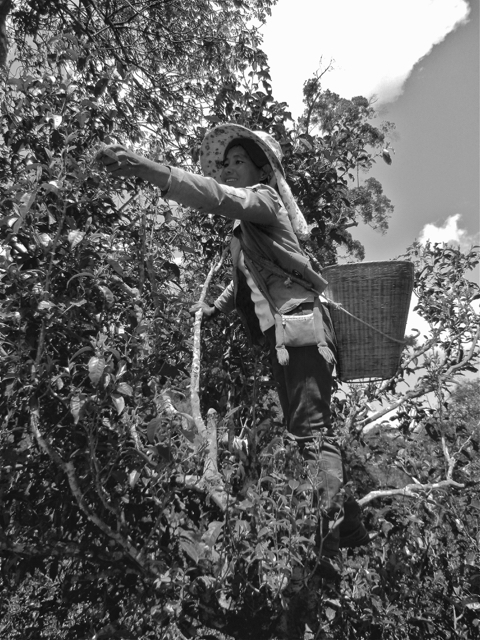
A superb article!!!!! Being relatively new to Pu’er and having just come back from Maocha sourcing trips in N.Thailand and N.Laos (400-700 year old big leaf trees), I was struggling to know how to differentiate between a new Sheng Pu’er and a simple green tea. Where’s the process line where you cross from green to Sheng, this article has helped greatly. In northern Laos in particular they still use the Bamboo tubes (mentioned in your article) to form the large leaves from the old tea trees into ‘tea cigars’. However I couldn’t find any locals that intentionally aged these leaves for personal consumption. The leaves pressed into raw Pu’er style cakes appeared to be all for export market.
Thanks for the note Alan – you’ve been into some wonderful areas in Laos and Thailand. There is much in terminology and lingo in the tea world that doesn’t really help with making things simpler. Interesting what you write regarding the locals not intentionally using aged leaves…same goes for Yunnan. Loose green Puerh dominates local palates and so much of the more curated shapes and ‘aged’ teas are destined for the outside. Important, I think, to put this info out there. Best, Jeff
Great article !
Hi, this is very interesting and I love to read all about your travels. I was wondering, I read a few different articles on how to store the cakes. I am a bit confused, some say to put in a paper bag or wooden box and store in a closet, yet another will say to put in a cardboard box with no airflow. Am I reading what you said right to leave the cakes open to air? Maybe in a box with it open?
Hi to you Denise and glad you’re joining the journeys.
Ideal storage of any Puerh is a space that isn’t humid or in touch with spice, scent, or anything with an odour of any sort. Puerh needs oxygen so something like a shoebox with the lid open is preferable. I simply stack them in a big unruly pile open away from the kitchen. All to say, yes, open box that doesn’t have a scent or smell of any sort. Tea is one of the great absorbers of surroundings. Hope this helps.
Great article, Jeff! I am glad to learn more about puer (and sheng in particular) after speaking with you at the Toronto Tea Festival.